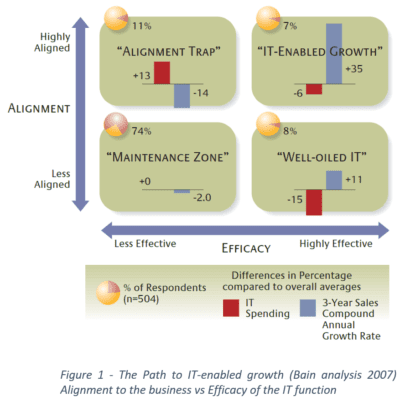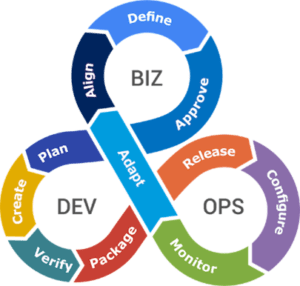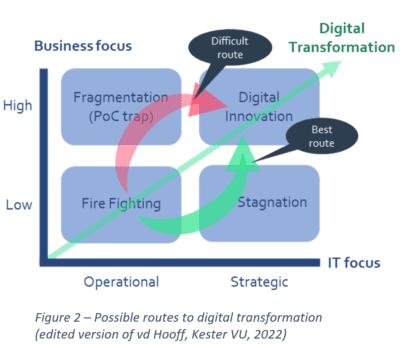Industry 4.0 developments are radically changing the current optimum of people, process and technology through technological advancements, like big data, IT processing capacity and connectivity. These so-called 4.0 innovations do not only provide added value for asset management, but for all domains within a company. Moreover, to harvest this value, these domains have to work together and technologies have to be integrated. In other words, the technological advancements affect the entire organization and that is why this change is characterized as a digital transformation. Related to asset management, digital transformation addresses all domains and technology types involved in the asset life cycle. This includes, but is not limited to, IT (Information Technology), OT (Operational Technology) and ET (Engineering Technology) and the departments which are typically involved are Portfolio Management, Project, Operations and Maintenance.
Two MaxGrip consultants, Erwin de Witt and Arjen van Bruchem, have researched the barriers for advancing digital transformation at various clients over the last year. In this article they list findings and share tips on how to overcome hurdles.
Barrier 1: The Proof of Concept (PoC) Trap
In many PoC projects it is possible to prove that utilizing the available data can be successful in reaching goals relating to asset management, such as a higher availability, safety or reducing cost. When diving further into these PoCs, you often find that the case and scope is relatively low-level, an improvised data connection is acceptable and data cleansing manually is doable due to the limited scope. However, this is not enough for scaling up across the organization as investments in connectivity, data processing, application software and more are required. Additionally, it is not possible to exactly predict the Return on Investment before starting the organization-wide digital transformation because this all depends on the availability of data, the quality of data, the quality of earlier digitization projects, the willingness of the organization to adopt new technologies and many more barriers. This is what we call the Proof of Concept Trap: there is proof that the technology can work but scaling up is part of Digital Transformation. As with social transformations, like our energy system or food system, this is a systemic change, which requires all stakeholders to move together.
Barrier 2: Not getting the most out of asset health insights
Utilizing the available asset data is key to optimizing maintenance and asset management. In our research we observed that organizations find it hard to use the asset data to their full potential. The data is essential for two reasons regarding digitalization: being able to predict failure and, in a bigger perspective, getting asset health insights to make better business decisions. Failure prediction has the potential to prevent unplanned failures, decrease inspection cost and to shift maintenance work to normal working hours. Asset health insight has the potential to provide insight into the asset lifecycle and thus optimizing the trade-off between maintenance and replacement or refurbishment. A reliable insight into asset health also ensures that the organization can prioritize and efficiently plan asset management activities. However, most organizations find it hard to utilize the available data. There are obvious barriers like the availability, validity, quantity and quality of data. We have also seen that organizations have difficulties to find a balance between complexity and efficacy. In other words, is the starting point that all data is valuable and should be gathered as much as possible (complexity) or is the starting point to search for specific causal data (efficacy). Both starting points are valid and the right balance should fit with the organization’s digital maturity.
Barrier 3: The alignment trap
IT’s job used to be ‘keep it running’ but digital advancements have more and more required IT to change their role to that of a business partner. Most organizations are already at a point that the IT availability is essential for running the business. IT, therefore, has a pivotal role in realizing digitalization projects in a safe and secure way.
Figure 1 shows an interesting figure, published in MIT Sloan management Review 2007, which is still very valid in our observation. Many companies are already aware of the importance of IT and business and IT invest in alignment. The problem, however, is that a business-focused IT organization tends to contribute to customized best-of-breed solutions, which increases the complexity of the IT infrastructure. In the end this may even contribute negatively to the overall performance. This is called the ‘alignment trap’.
Like we said above, while PoCs at many companies are successful, scaling up requires an effective IT organization. One main challenge for efficacy of IT organizations is reducing complexity by e.g. standardizing, building a simplified infrastructure, creating a data model and getting rid of legacy systems. This IT infrastructure should effectively address IT barriers like performance issues, privacy and security challenges and system integration issues. Although this sounds obvious, the cheapest and quickest way to facilitate a business request, is to respond with a customized solution. Building a simplified, resilient and flexible infrastructure in contract, requires time and money upfront.

Tips to take the next step
The pitfall of transformation is that everybody is waiting for each other to take the next step. Luckily, there is a way out by just starting the change as ‘good behavior is contagious’. So, immerse yourself in the subject and just go for it. Four tips that can help:


Conclusion
Summarized, digital transformation requires digital leadership (vertical alignment) and cooperation between departments or disciplines which have so far worked in isolation (horizontal alignment). This resonates perfectly with the principles of asset management (e.g. line of sight and an asset lifecycle approach). Applying these principles in a modern agile way with involvement of the (frontline) workforce will put you on the road to a successful transformation.
📰 Download free whitepaper report of Industry Leaders Round Table
Get inspired
The seven benefits and six critical success factors for a successful implementation of Autonomous Maintenance.
Learn why kitting is important for an efficient MRO strategy, how it helps to increase wrench time and reduce costs.
Though condition-based maintenance and predictive maintenance have some overlap, they are not technically the same.




